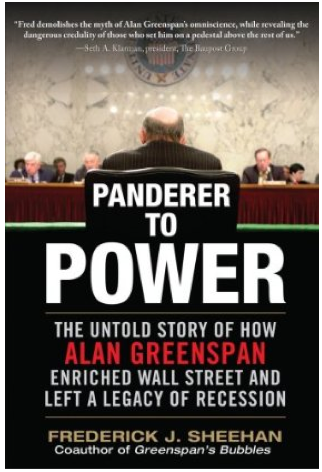 Frederick Sheehan is the co-author of Greenspan’s Bubbles: The Age of Ignorance at the Federal Reserve.
Frederick Sheehan is the co-author of Greenspan’s Bubbles: The Age of Ignorance at the Federal Reserve.
His new book, Panderer for Power: The True Story of How Alan Greenspan Enriched Wall Street and Left a Legacy of Recession, was published by McGraw-Hill in November 2009. He was Director of Asset Allocation Services at John Hancock Financial Services in Boston. In this capacity, he set investment policy and asset allocation for institutional pension plans.
~~~
We always need nurses, but the question arises whether there are enough hospitals, doctors, machinery and bedpans to employ the trainees. There are plenty of unemployed nurses now. For those who pursue this path, they may be entering at a market top. This would not be the first time. Remember the CEO’s who left their firms in 1999 and 2000 to start Internet companies? In that case, technology and telecom companies had risen from 5.6% of the S&P 500 in December 1993 to 38.8% in June 2000.
Today, health costs in the United States are about 16% of the national income (GDP), over twice the percentage in Japan, Finland and Norway, all of which have longer life expectancies than in the U.S. The proportion of the American economy devoted to health care will no doubt rise before it recedes, but recede it will.
Instead of joining the battalion of nurses, it could be more profitable to study a field that is bound to grow: energy. The cost of energy is about 5% of world GDP. This will rise considerably. Andy Lees, who heads a macro sales team at UBS in London, estimates the proportion will rise to around 16% of world GDP. Lees wrote a book in which he explains his calculations, The Weakest Link (which can be downloaded at http://r20.rs6.net/tn.jsp?et=1103599201225&s=0&e=00168p5eKisNm2ePOsUMC8Gep0gl0I6QRDjsfgyYtG7u_FlWYNWX4ymzaba4HEOKBG2XPkWnO9VM0NuQkPJKsqXY8PDjLQhOjdZv4yyg39MBnsLr0ETBrKZvFEm8gfzB9_n2u2oyz1Xf78aZal3kGj58TdoT8KkU77k).
For purposes of career guidance, it is sufficient to say that oil-out-of-the-ground is less of a burden on the world economy than other forms of energy. Onshore oil production peaked in 1978. Offshore oil has carried the torch, but its extraction is less efficient. Efficiencies attenuate from “factor inputs” (Andy Lees’ term). The factor inputs are land, labor, capital, and resources.
Oil consumption is the product of inputs. Since more inputs are required to produce a barrel of offshore oil, fewer inputs are available for health care. Natural gas, liquefied natural gas, wind power, solar power, ethanol, nuclear fusion may substitute for oil – at a cost. This also presents opportunities.
Back to the nursing program, the graduates are only employable if energy is available. The more expensive or unwieldy the energy, the fewer number of nurses will find jobs. This relationship can be extended across the world economy. Energy might be considered a cost of the world’s work. The combination of factor inputs compose that cost. The race will be on to produce energy with the lowest consumption of inputs.
Not much thought is given to these factors, possibly because we do not rely on alternative energies yet, so myth-making and waste is still possible. A look at substitute energies might help the job seeker evaluate future employment.
Solar power loses about 70% of its energy during storage. Around 70% to 80% of energy is lost in the process of upgrading corn into ethanol. Wind power suffers from loss of energy in storage, in transmission, and from the declining grade of copper from mines. (Copper is used in wind-power transformers and ground rings.) Copper ore grades have declined for many years so costs have risen. Costs include more exploration (requiring more land, labor and capital), water (Chile recently banned miners from using fresh water, forcing the companies to build desalinization plants and possibly importing water from Argentina), and longer shipping routes (as remote areas are explored and mined). Longer shipping routes consume more energy (fuel), steel (ships), iron ore (to produce steel), land (mining sites) and labor (to fulfill these requirements).
This case study barely touches the costs and opportunities ahead. The reader might consider where pressures will be greatest, and where employing one’s own land, labor, capital, and resources will be most profitable.
While exploring these paths, it is important to consider timeliness. The United States is a laggard. Following are stories read on the same day (July 14, 2010). China is building an oil refinery in Lagos, Nigeria. In Argentina, China is building a rail network (for cheaper transportation of farm crops) and a subway system. Brazil is building a high-speed rail network between Rio and Sao Paulo. Diamond Offshore Drilling is moving a second deepwater rig out of the Gulf of Mexico to the Congo. Americans seem to think Washington will set the course, a vain hope. Time would be more profitably spent buying a farm or an airplane ticket.


What's been said:
Discussions found on the web: